Everything you ever wanted to know about hot pot
One of my all time favorite meals is hot pot. We eat it at least once a month, if not more.
It can be a cold and cozy night or a warm summer evening – it doesn’t matter because hot pot is always the answer. It’s a fun and filling way to spend the night eating and chatting because you’re literally hanging around a hot pot at the table where you cook and eat together.
Essentially, all you do to prepare hot pot is make a soup that is simmered at the table. You load up the table with a bunch of raw sliced meats, veggies, tofu, seafood, and noodles. Everyone cooks what they like, right at the table. Then it’s scooped out of the pot, dipped into your own customized sauce, and devoured.
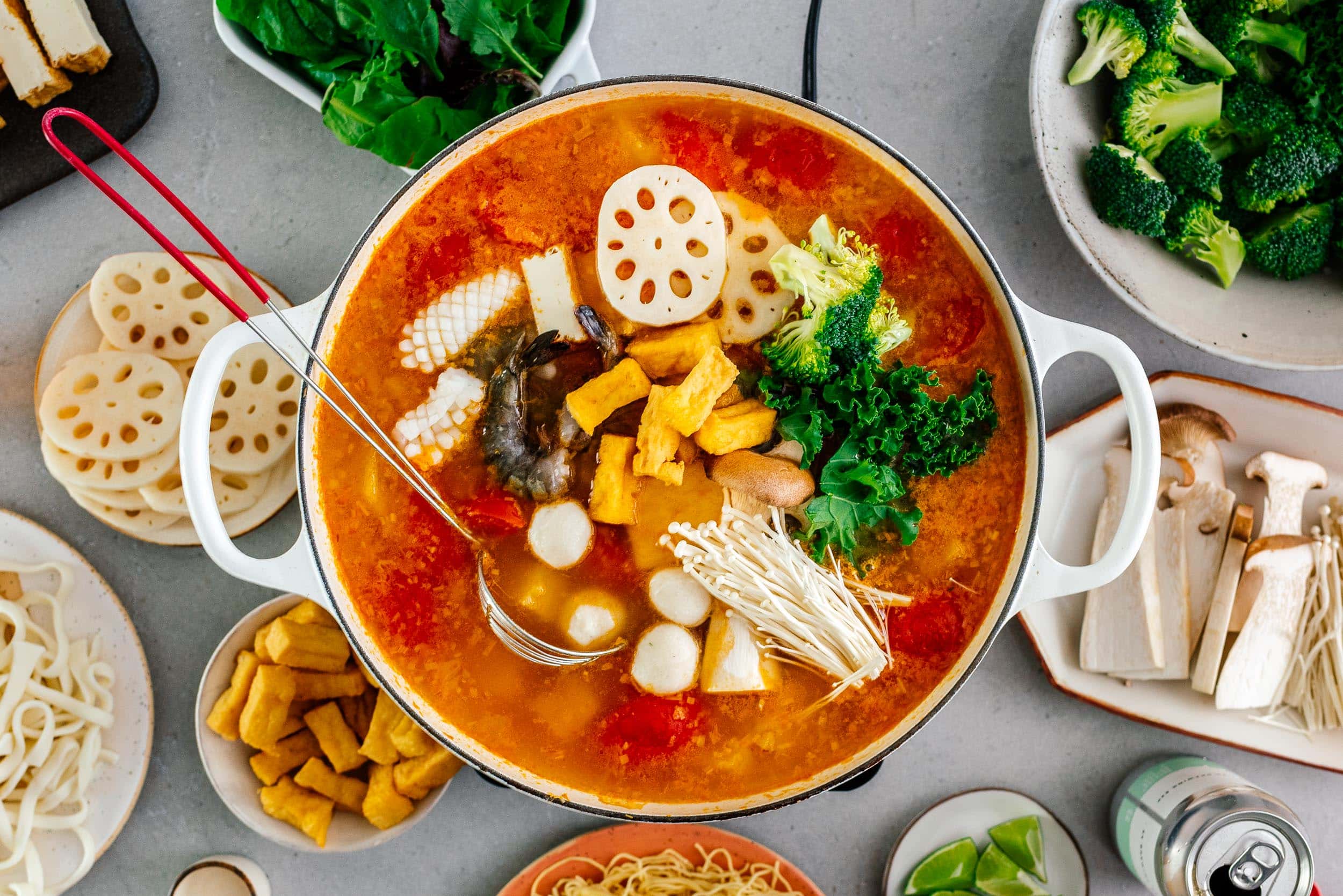

Hot pot is all about choosing your ingredients/what you’re going to put into your pot. There’s a huge variety of hot pot, even within China – there’s mind numbing spicy hot pots, herbal hot pots, curry hot pots, soothing plain hot pots, really there’s no wrong way. Here’s an in-depth guide to get you started!
What is hot pot?
If you’re new to hot pot, it’s a low stress way to have a fun and interactive meal with the people you love. Hot pot is a social way of eating: a variety of food is cooked in a communal simmering pot of flavored broth. The meal starts with the pot coming to a boil. The meat, seafood, vegetables, tofu, and noodles are added and cook quickly (and sometimes slowly) in the bubbling broth. Everyone scoops out whatever their heart desires and adds more to replace it. Fun times, yummy food, and much laughter is shared.
At its core, Hot pot is a Chinese way of way of cooking food in a simmering pot of soup at the table. It’s similar to fondue, except instead of cheese or hot oil, you have a flavorful soup stock. Raw ingredients are cooked in the soup, then eaten with dipping sauces. It’s a fun and communal way of eating and super popular both at home and in restaurants.
Hot pot is near and dear to Chinese people across the world and is starting to become more mainstream and popular. Hot pot creates a cozy, warm atmosphere and really brings people together as you sit around a pot, cooking, eating, talking, and relaxing. The food is important but also important are the feels and the feels of hot pot can’t be beat.


Is it really this complicated?
NO! This is an all encompassing how-to guide but the tl;dr of it all is that you can just go to your local Asian supermarketand buy from their hot pot selection. If you live somewhere far away from one, you can buy the hot pot soup mix online, thinly slice some proteins, wash some veg, and have at it. It doesn’t need to be hard.
Where does hot pot come from?
Hot pot originated in China but it’s now all over Asia in different incarnations. There are bubbly Korean stews, Japanese shabu shabus, Vietnamese hot pots, and more!
How to have hot pot at home
- Decide on the broth. Go homemade or store bought, either work great.
- Shop for the ingredients. Go to the (ideally Asian) grocery store and buy ALL THE THINGS.
- Prep: wash the vegetables, lay out the meats, seafood, dumplings, balls, vegetables, and noodles out on plates or trays. Keep the meats together, the seafoods together, the vegetables together, the dumplings together, and on and on so that everything is contained and separate.
- Set the table. Set the table with everything you need, more on that below!
- Hot pot! Bring the soup up to a boil, cook your ingredients at the table, dip in sauce, eat, drink, laugh, enjoy.
What equipment do I need for hot pot?
Essentially you need two pieces of equipment for hot pot: a burner and a pot. The burner needs to be portable enough to sit at the center of your table. It can be anything you like, but make sure it’s not charcoal because it’ll fill your home with carbon monoxide.
For the burner, there are several ways to go: induction, gas, or a two-in-one pot connected to electric source. I say you go with whichever one you might already have, or if you are going to be buying something, I’d choose induction. Induction is easy to clean – just wipe it down. Plus you don’t need to buy extra gas canisters. We’ve used the two-in-one before too, but it’s easier to use a pot you already have.
As for pots, you want one that’s shallow so your food isn’t drowning. You want to be able to see it floating in there so a deep stockpot isn’t going to cut it. Growing up, we always had a split pot so the adults could have spicy soup while the kids had a mild soup. Split pots are great for people who want two kinds of soup or if you want to keep one side for meat and the other side for vegetables.
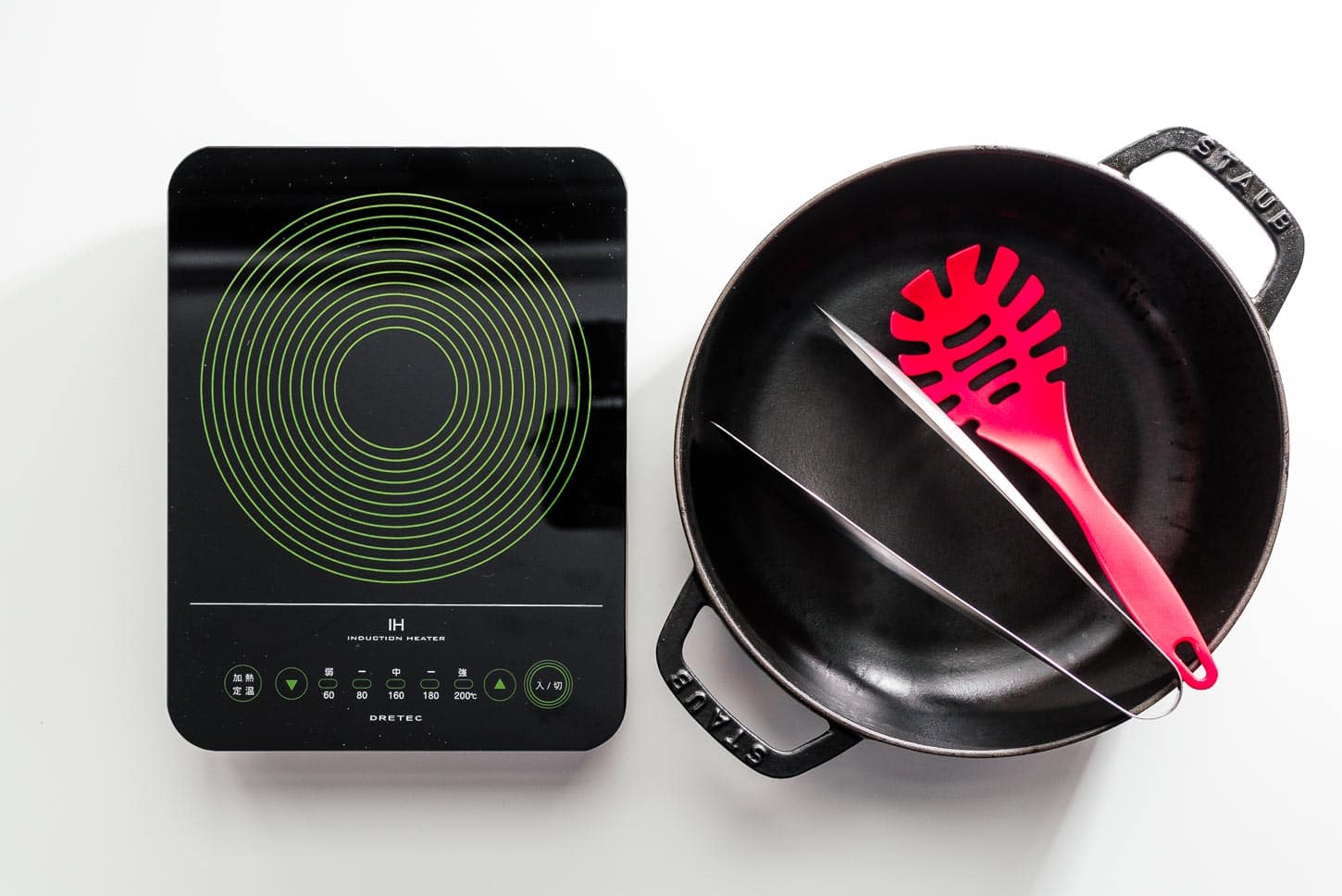

Our personal hot pot set up
Mike and I use a portable induction cooker with our favorite cast iron shallow brasier, it retains heat amazingly and after we’re done, we just wipe down the induction cooker and pop the brasier in the dishwasher.
There are three main components of Chinese hot pot: broth, ingredients, and sauce.
Hot Pot Broth
There are a bunch of different variations of hot pot in China, depending on the region, it goes from fiery red and spicy (Sichuan and Chongqing) to milky and herbal.
Soup is the backbone of your hot pot, but really, you don’t need to worry about it too much. If you want to go all out and make a homemade stock, go for it. Sometimes if I’m feeling particularly extra, I’ll do just that, but more often than not, I’ll just use a store bought stock or seasoning packet.
Our favorite base happens to be Japanese dashi with soy, sake, mirin, and a touch of sugar. It isn’t Chinese at all, but, you know, since hot pot is all about customization, we are here for it, especially since it reminds us of oden. The light yet deep umami richness is the perfect flavor for all the ingredients to soak up.
Store bought broth
Lee Kum Kee makes a large variety of seasoning packets – you can find those and all of the ingredients for Chinese hot pot at your local Asian grocery store. If you’re looking for spicy, Hai Di Lao is a famous Chinese hot pot restaurant that sells their hot pot seasoning packets. There’s also an extremely popular hot pot restaurant (Little Sheep Hot Pot) that sells its soup base as well. Be careful of store bought packages, because some of them can be extra extra spicy. If the ingredients list mentions mala or sichuan pepper, you might be in for a spice-fest. When in doubt, use a half- or a quarter-package and taste test beforehand.
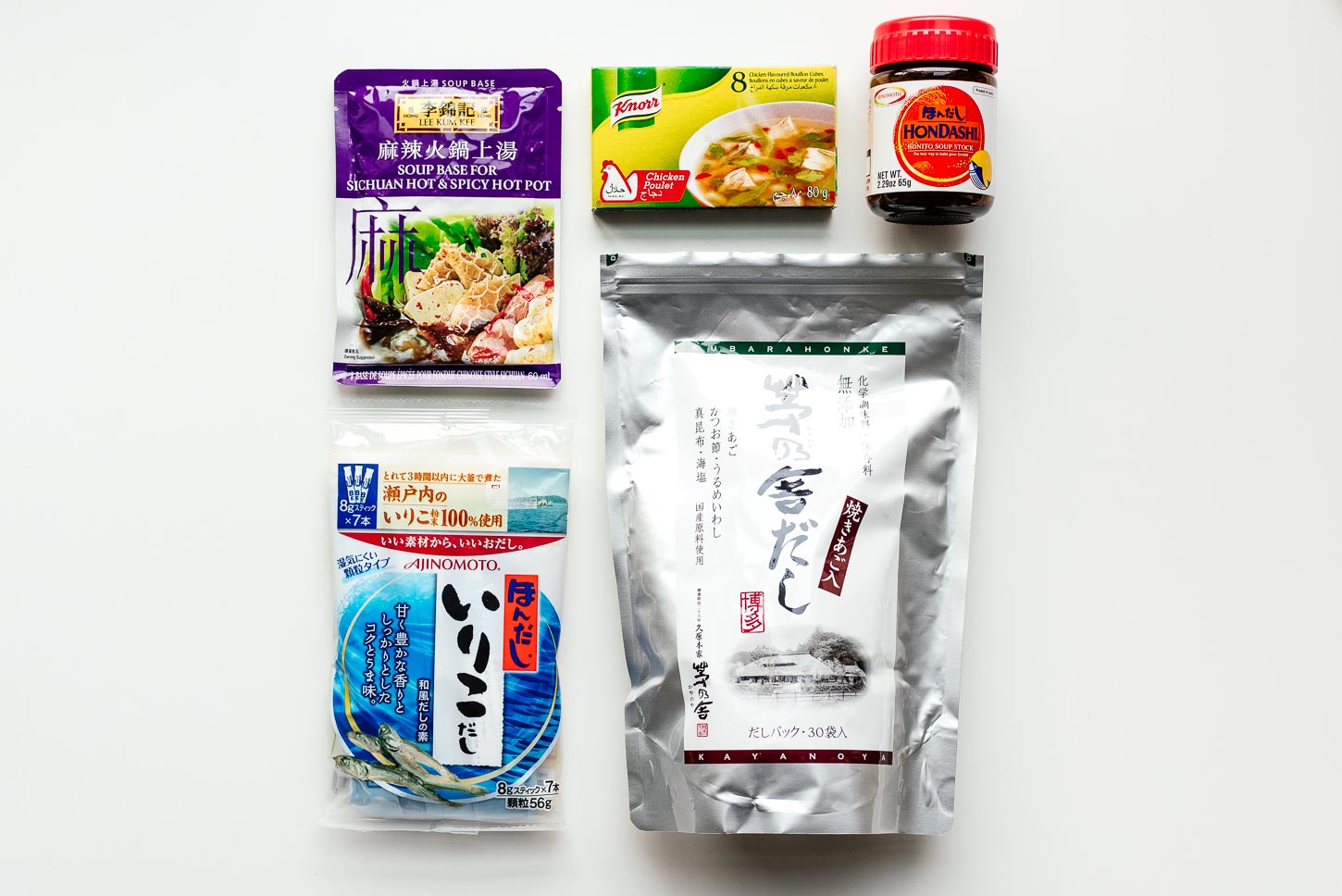

Homemade hot pot broth
Most days, we just use a simple no sodium chicken stock dressed up with some soy sauce, shaoxing wine, toasted sesame oil, ginger, and scallions. For a Japanese dashi flavor, use instant dashi seasoned with soy, sake, mirin, and a touch of sugar.
How much broth do I need?
You’ll need enough broth to fill your pot. Most seasoning packages have enough to make 6-8 cups. All you do is mix the packet with water. As you’re cooking your hot pot, the soup base will inevitably go down, just top it up with water, there’s no need to add extra flavoring because the soup intensifies and concentrates as it boils down.
Hot Pot Ingredients
This is the MOST fun part of hot pot. If you love variety and eating a bunch of different things in one meal, this is the meal for you! The best kind of hot pot contains a little thinly sliced meat, a little seafood, some veg, tofu, dumplings, and noodles of course! Everything tastes amazing when cooked in a hot pot. And the best part is, all you’re really doing is buying fresh, raw ingredients.
If you’re wondering where to buy hot pot ingredients, the answer is an Asian grocery store! All grocery stores will (obviously) carry different things, but my main recommendation is to hit up any Asian grocery store because they will have a huge selection to choose from. I’ll break down the different categories of ingredients; it’s best to try to get a couple of each category.
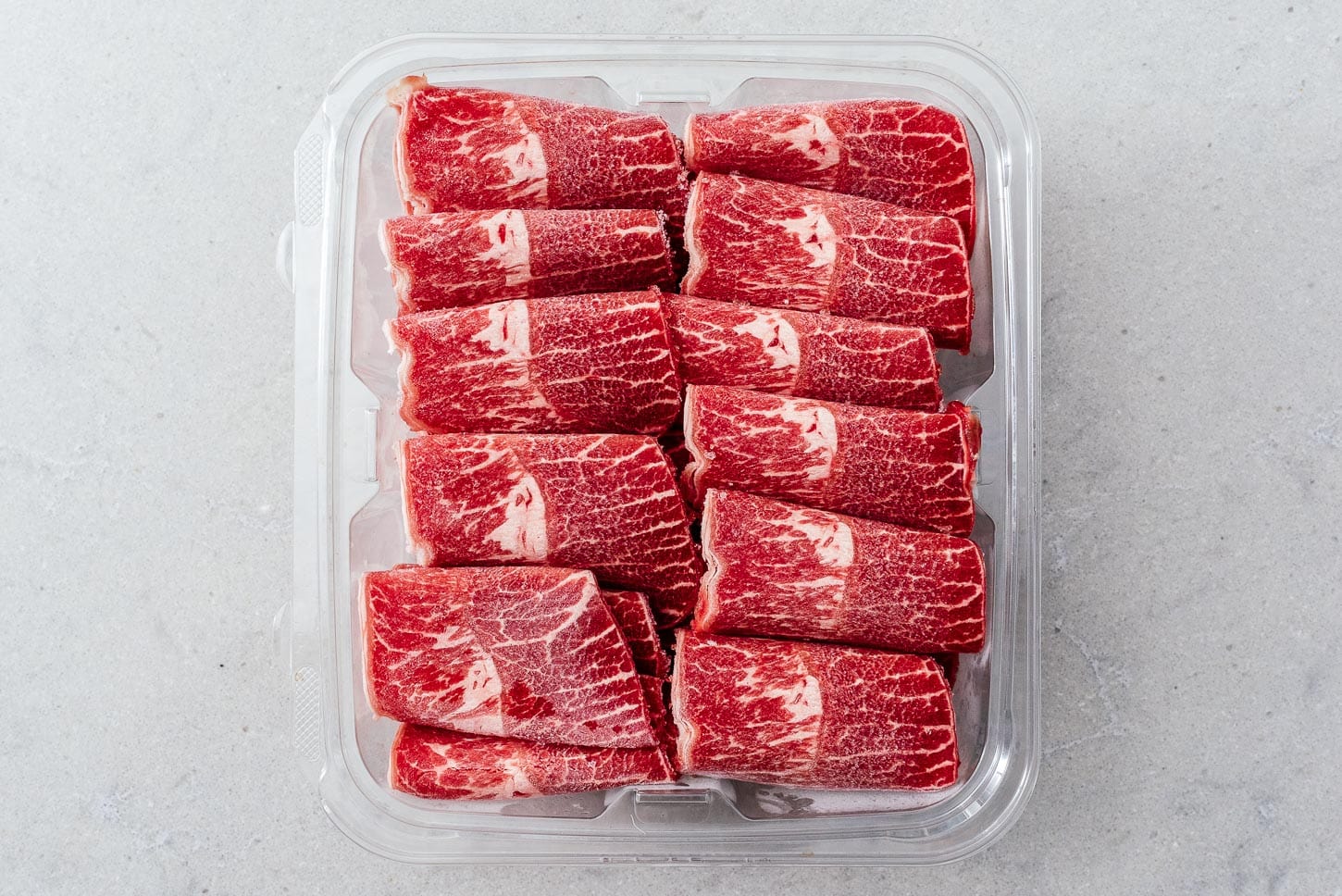

Thinly sliced meats
Meat, it’s what hot pot is for. Essentially you can cook any kind of meat in hot pot, as long as it’s sliced thinly. You pop it into the boiling water, swish it around a bit and let the pot come back up to a boil, pull it out and eat it. Typically thinly sliced beef, pork, and chicken are very popular. There are a variety of cuts that you can get thinly sliced in trays at your Asian grocery store – go wild and buy a bunch. Some of our favorites are: rib eye, pork belly, pork jowl, lamb shoulder, and pork shoulder.
Or, if you like, you can DIY it! Pick pieces of meat that are heavily marbled and pop them in the freezer for about 30 minutes – it should feel slightly solid, but still yield, and then slice it as thinly as possible.
Seafood
Seafood is a very common addition to hot pot but it’s something we often skip. When we do it, we actually love those frozen seafood medley packs that contain shrimp, squid, scallops, and sometimes even mussels and clams. Fresh fish is a good bet too when we’re splurging (or feeling healthy)
Vegetables
Traditionally chinese hot pot is a bit light on the veg but vegetables are Mike’s favorite part of hot pot (sometimes I think he could eat hot pot with just a head of lettuce) and I’ve come over to the healthy side. I like a bit more variety, so I usually include some sort of Asian vegetable (gai lan, as pictured) and mushrooms. Anything goes, just make sure you’re not over cooking your vegetables! Pop them in, let them cook, then pull them out immediately, unless they’re the starchy variety of vegetable like daikon, potatoes, sweet potatoes, and taro. Tomatoes are amazing in hot pot, but be careful because they get really hot!
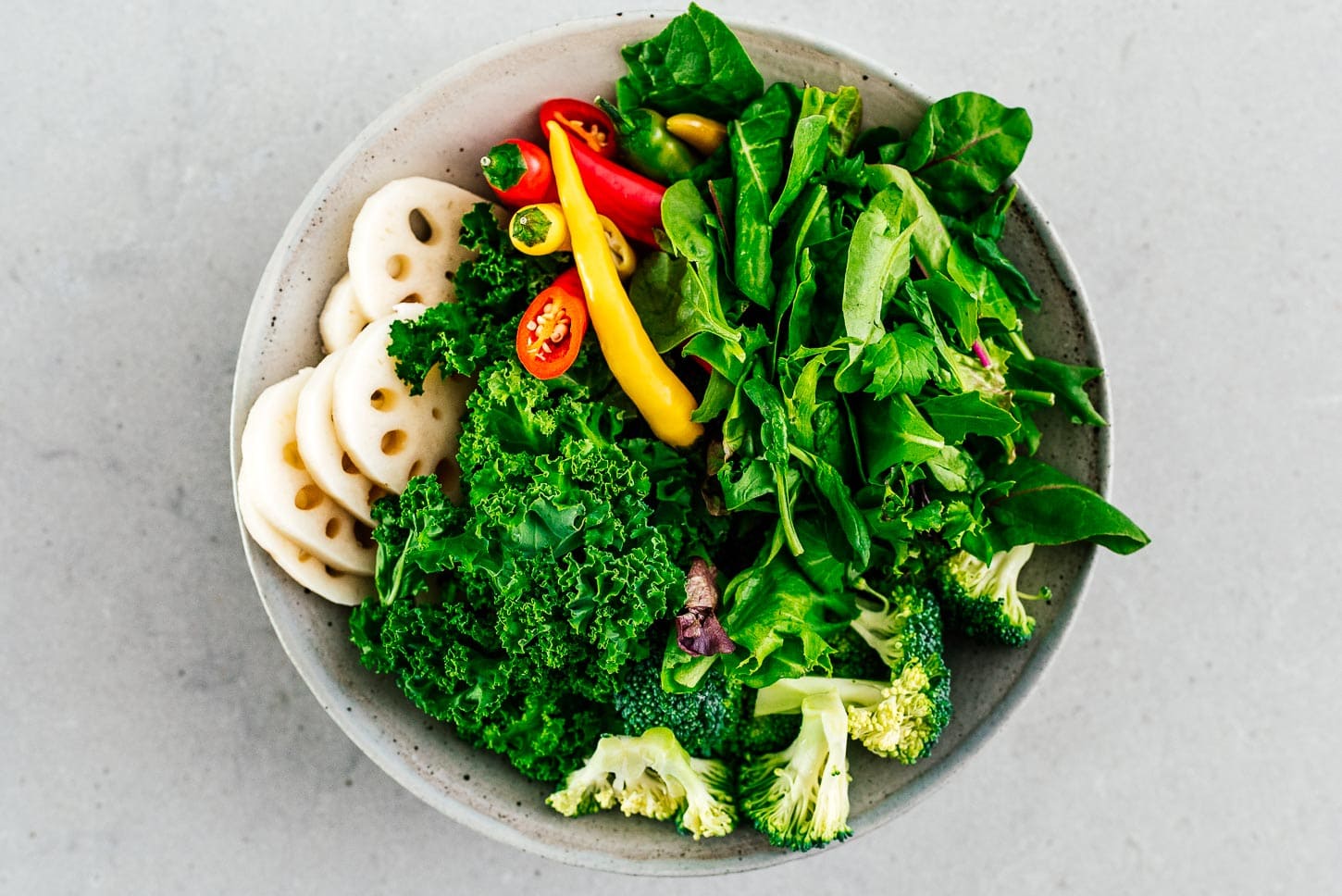

Tofu
Tofu hot pots are a thing all by themselves. There is a huge variety of tofu at Asian grocery stores and they are all amazing. Tofu is some of the best stuff to put in hot pot because they soak up all the flavors. Mike’s partial to mini tofu puffs and I like medium firm tofu. I also love egg tofu, the kind that comes in a tube.
When you’re popping the tofu into the hot pot, it doesn’t need long because you can essentially eat tofu “raw” but if you let it simmer for a while it’ll be one of the best bites: juicy and full of all the delicious hot pot soup.
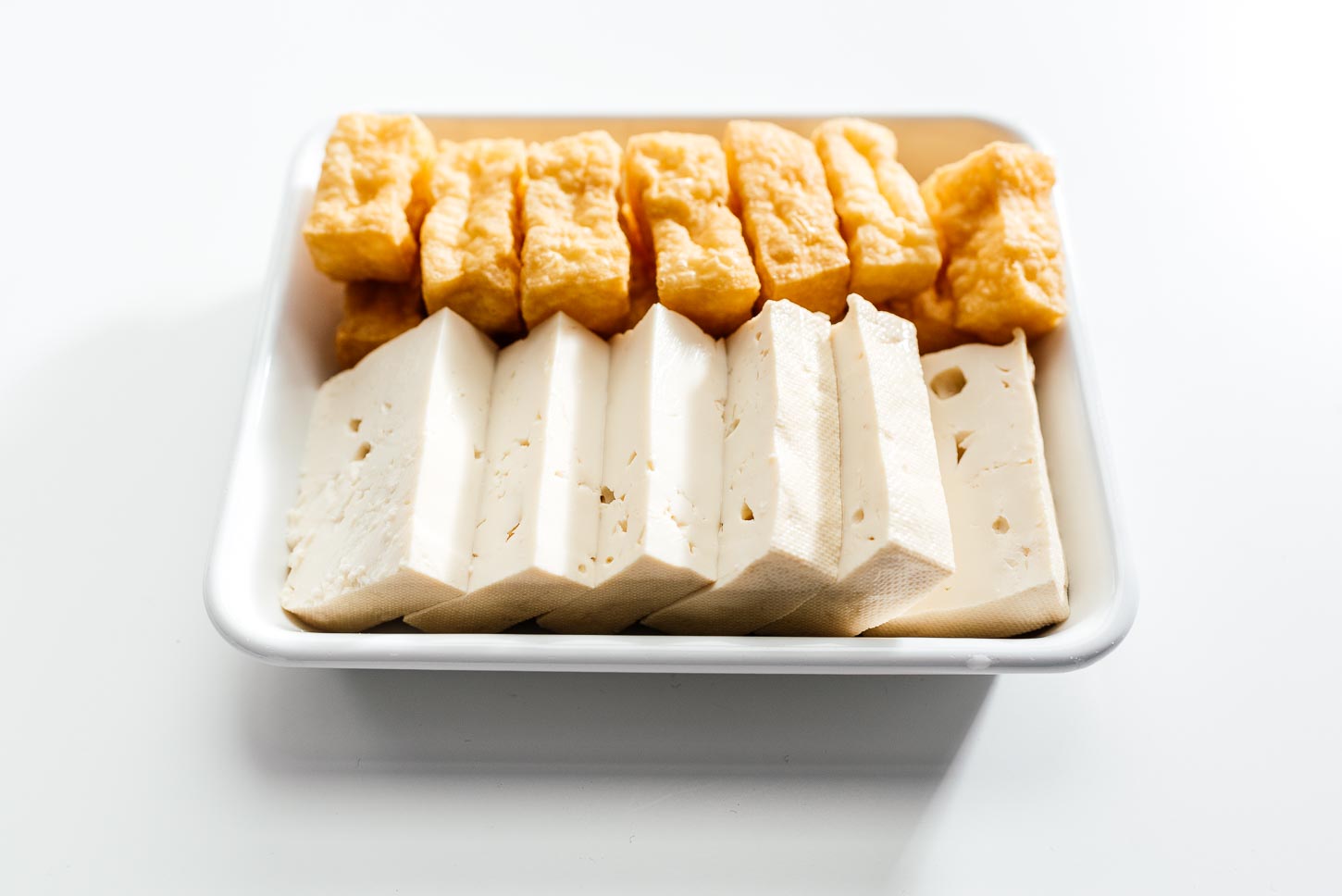

Fish balls and meatballs
When you get to the Asian grocery store, head to the frozen section. Sometimes there will also be a case beside the fish where fresh fish balls are. Fish balls, if you haven’t had them, are the bomb. They have the best texture and are not very fishy. They’re kind of hard to explain, but trust me, you’ll love them. I call them fish balls, but they come in all kinds of flavors: shrimp, squid, cuttlefish, lobster – if it swims, it comes in fishball form. I particularly like the “golden” ones because they’re deep fried. Oh, and grab some meatballs too, they usually have these in the deli section – in our local store we have a selection of Vietnamese meatballs and I always grab some to throw in.
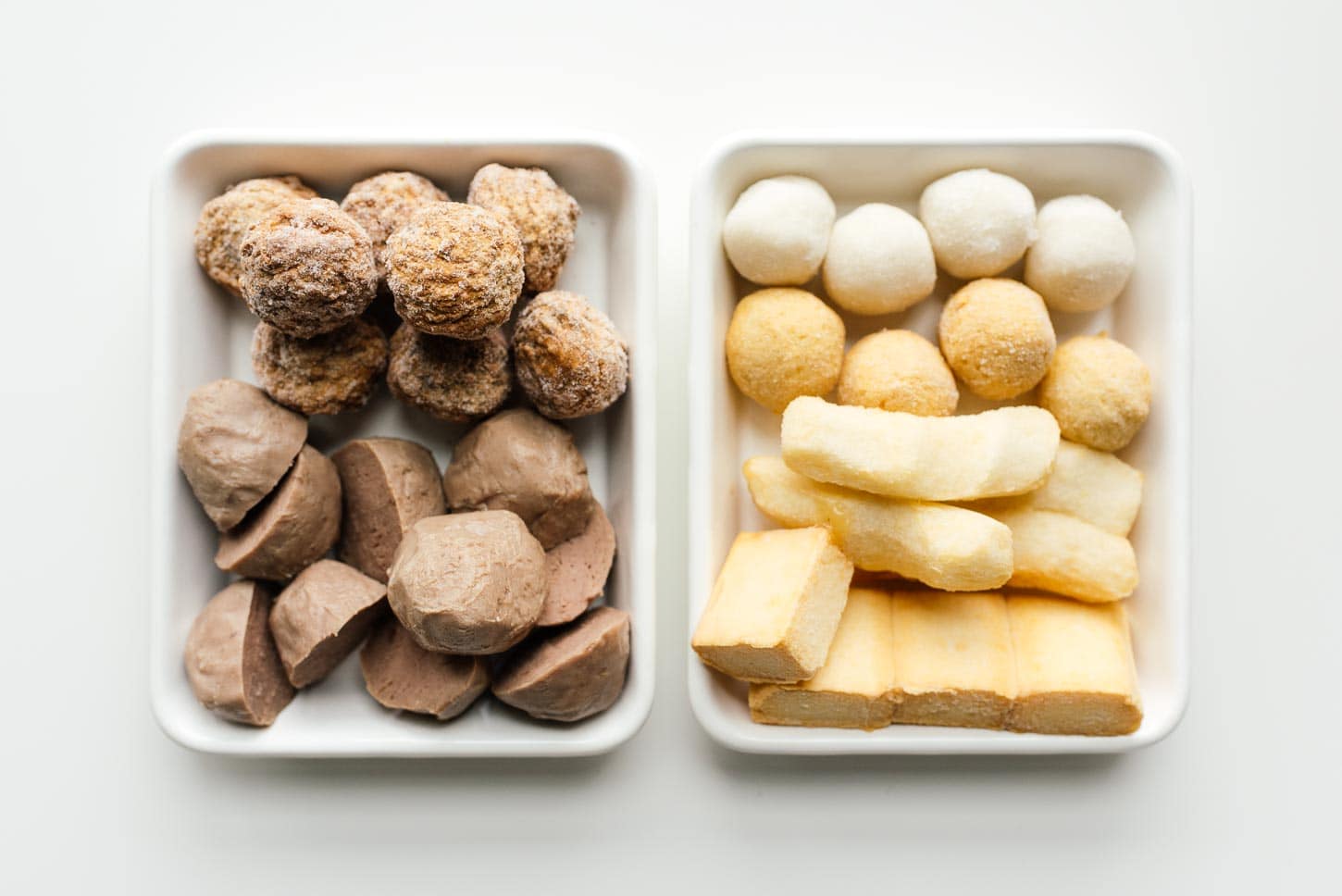

Dumplings
Speaking of dumplings, grab some frozen dumplings to put in your hot pot. I like to get the ones that are already fully cooked since you can’t really see inside them. Those packages will feature a large “fully cooked” text on the front. Getting fully cooked dumplings ensures that you don’t accidentally pull out a dumpling and bite into a raw filling. Get the classic pork and vegetable combo and if you see it, go for pork and corn, it’s my fave.
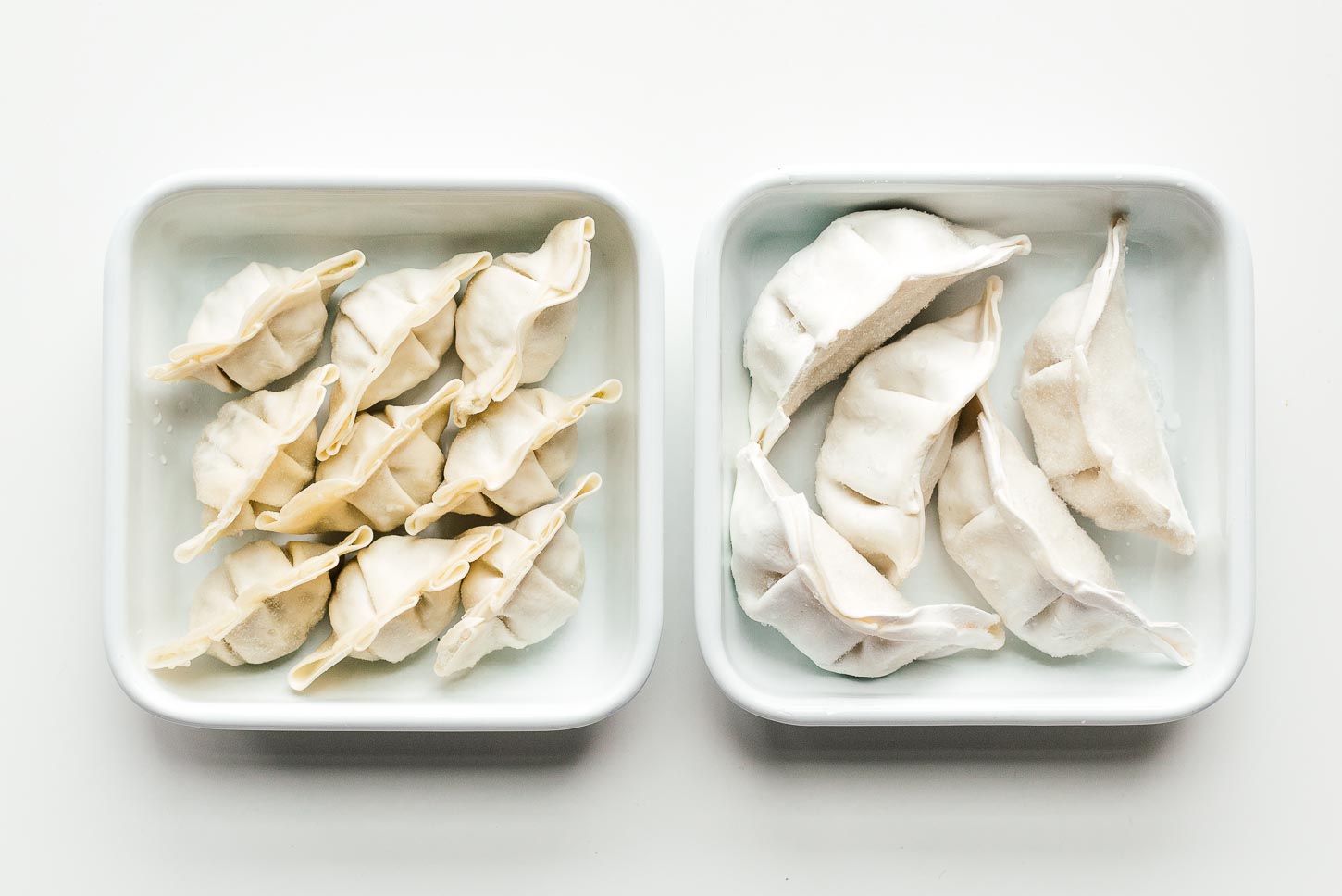

Noodles
Noodles are the carb of choice for hot pot, they go right into the soup and soak up all the flavors. Sometimes people have bowls of rice too, so if that’s what floats your hot pot boat, go for it! I love noodles, so they’re essential. I usually go for udon because they’re thick and chewy and delicious, but mung bean noodles are excellent at soaking up flavor too. Shirataki is also amazing if you’re going low carb or keto.
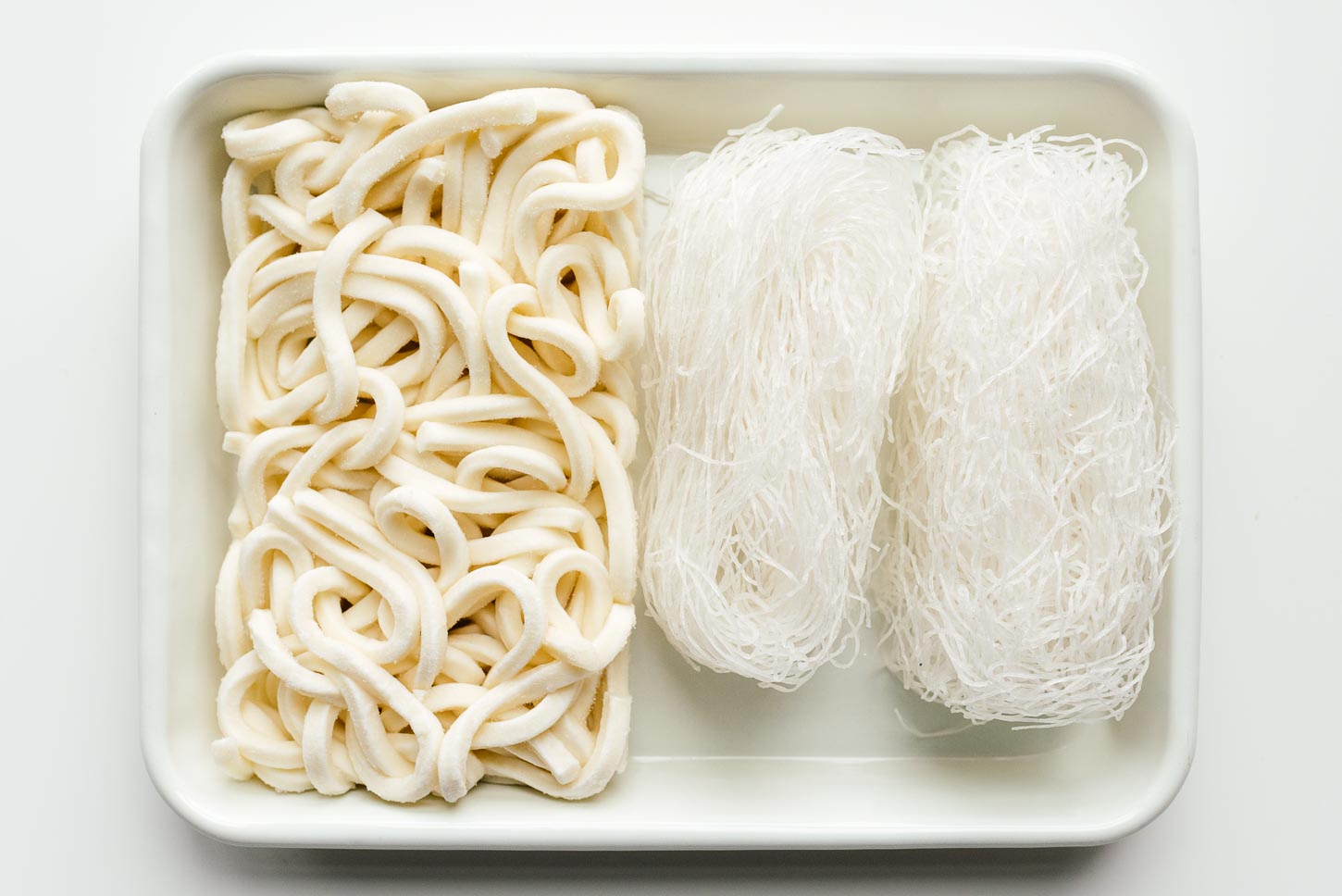

How to prep ingredients for hot pot
If you have a bunch of ready to go items like sliced meats, seafoods, and various balls, just open up the packages and put everything out on plates. I like to put everything on separate plates, but if you don’t have enough plates, it’s best to keep the meats, vegetables, and frozen stuff separated. Depending on how much you bought, you won’t need to put everything out – but if you have a big table, it never hurts and is always impressive!
- Meats: If you have whole cuts of meat, place them in the freezer for 20-30 minutes until slightly firm (this helps a LOT!) and thinly slice.
- Seafood: Cut into bite sized pieces for quick and even cooking.
- Vegetables: Wash and dry all the vegetables. For large leaf and root vegetables, cut them into small pieces.
- Tofu: Drain and cut into bite size pieces.
- Noodles: Remove from the package. For most noodles, it’s best to soak in hot water for 30 seconds and drain first.
- Balls and dumplings: Remove from the packages. If you like you can slice the balls in half. Make sure you don’t put the dumplings out too early because they’ll melt.
Hot pot sauces
Here’s where the fun starts: the dipping. Everything that comes out of the hot pot is dipped in sauce. Well, maybe not the noodles, but you know, you can pour sauce on to those. Every family has their own version of hot pot dipping sauce ingredients and within that everyone has their own personal sauce recipe. Provide a bunch of sauces and let people mix and match. Growing up, I just dipped in a simple sweet soy sauce with green onion and cilantro mix, but now I prefer a mix of Chinese sesame paste, hoisin sauce, sweet soy sauce, and shacha (Chinese barbecue sauce).
Shacha sauce
If there’s a sauce that I think is always offered with hot pot, aside from soy sauce, it’s shacha. Shacha is made from soybean oil, garlic, shallots, chilis, brill fish, and dried shrimp. It’s an umami bomb and so so delicious. Shacha is from Taiwan and the best brand is Bullhead and it comes in a little silver can (although it actually comes in a big can too and that’s what we have in our fridge) with a resealable top. Confusingly, it’s labeled as Chinese barbecue sauce. Give it a good mix before you scoop some out, the good stuff usually settles at the bottom. People typically mix it up with a bit of soy sauce, sesame oil, green onions, and cilantro. Some people also mix in a raw egg yolk for an extra bit of oomph. They sell it at the Asian grocery store and online.
Sesame sauce
Sesame paste or sesame sauce is the other big gun at the sauce table. Essentially it’s Chinese sesame paste – which is similar to tahini but made with toasted sesame seeds and it’s nuttier, deeper, and more toasty tasting .You can have sesame sauce on it’s own diluted with a bit of water, soy sauce, and toasted sesame oil, sprinkled with cilantro and scallions, or you can mix it up with other sauces. It’s super thick, so give it a good stir (just like natural almond butter!) before using. They sell it at the Asian grocery store and online. Whangzhihe is probably the most common sesame paste sauce you’ll see.
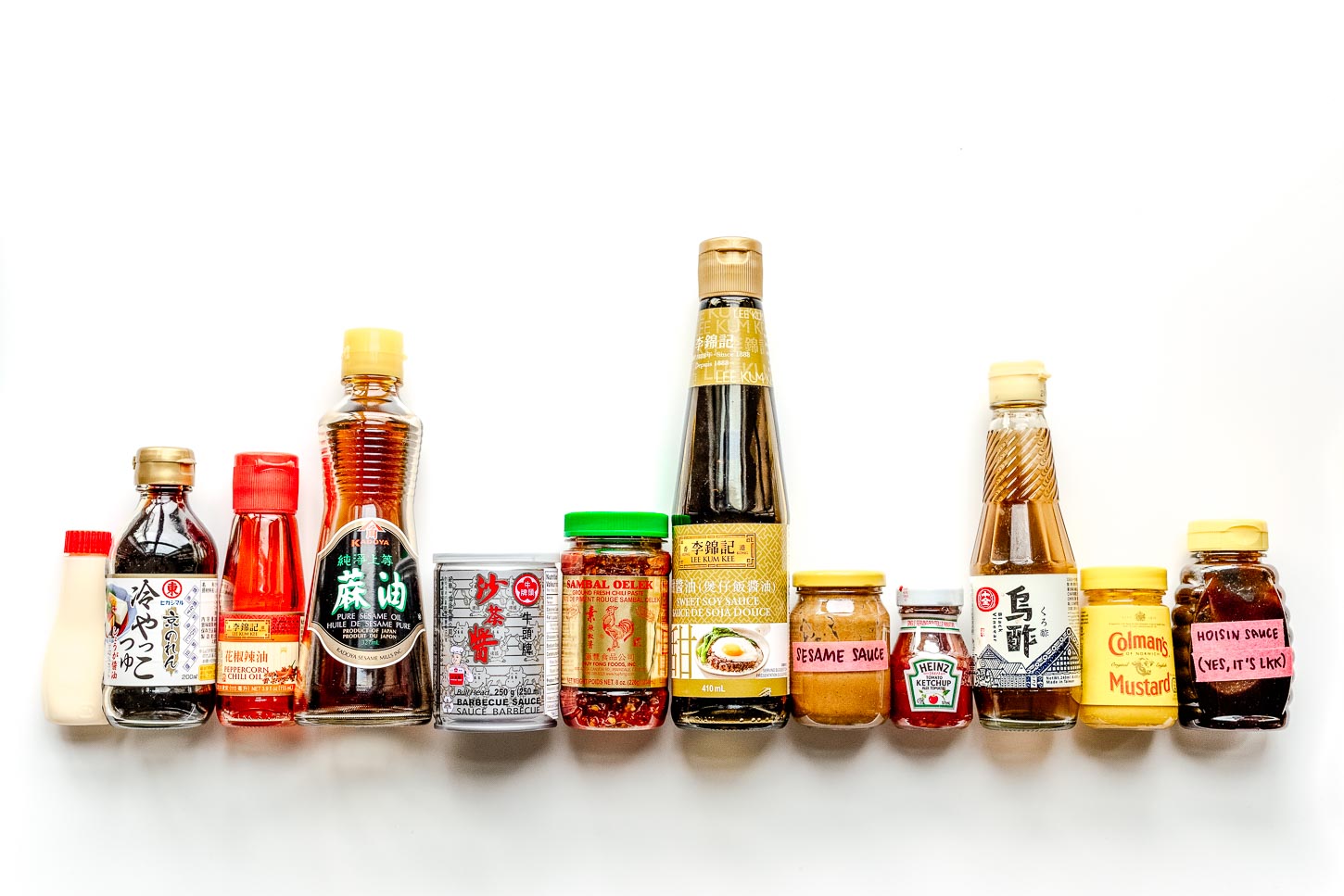

How to set the table for hot pot
Now that all the shopping and prep is done, it’s time to set the table.
- Place the burner and the pot in the middle of the table.
- Arrange the ingredients around the table.
- Have a sauce station – usually it’s a little nicer to have the station away from the table since it frees up space. We put all the sauces on the counter and head there when we need refills. Have little dipping bowls to mix up sauce in, sometimes you might even want 2 sauce dishes per person!
- Place a bowl, plate, chopsticks, and napkin at each setting.
- Have a couple of plates with tongs and hot pot strainers (the little individual scoop-y thing you see in the photo), and a ladle. It’s nice if you have one hot pot strainer per person but if you’re good at sharing, you can get away with one between two people.
- Don’t forget the drinks! You can go with beer or if you want those authentic feels, try wine! Wine is crazy popular in China. If you’re doing non alcoholic, iced green or jasmine teas or suan mei tang aka cold sour plum tea are good choices.
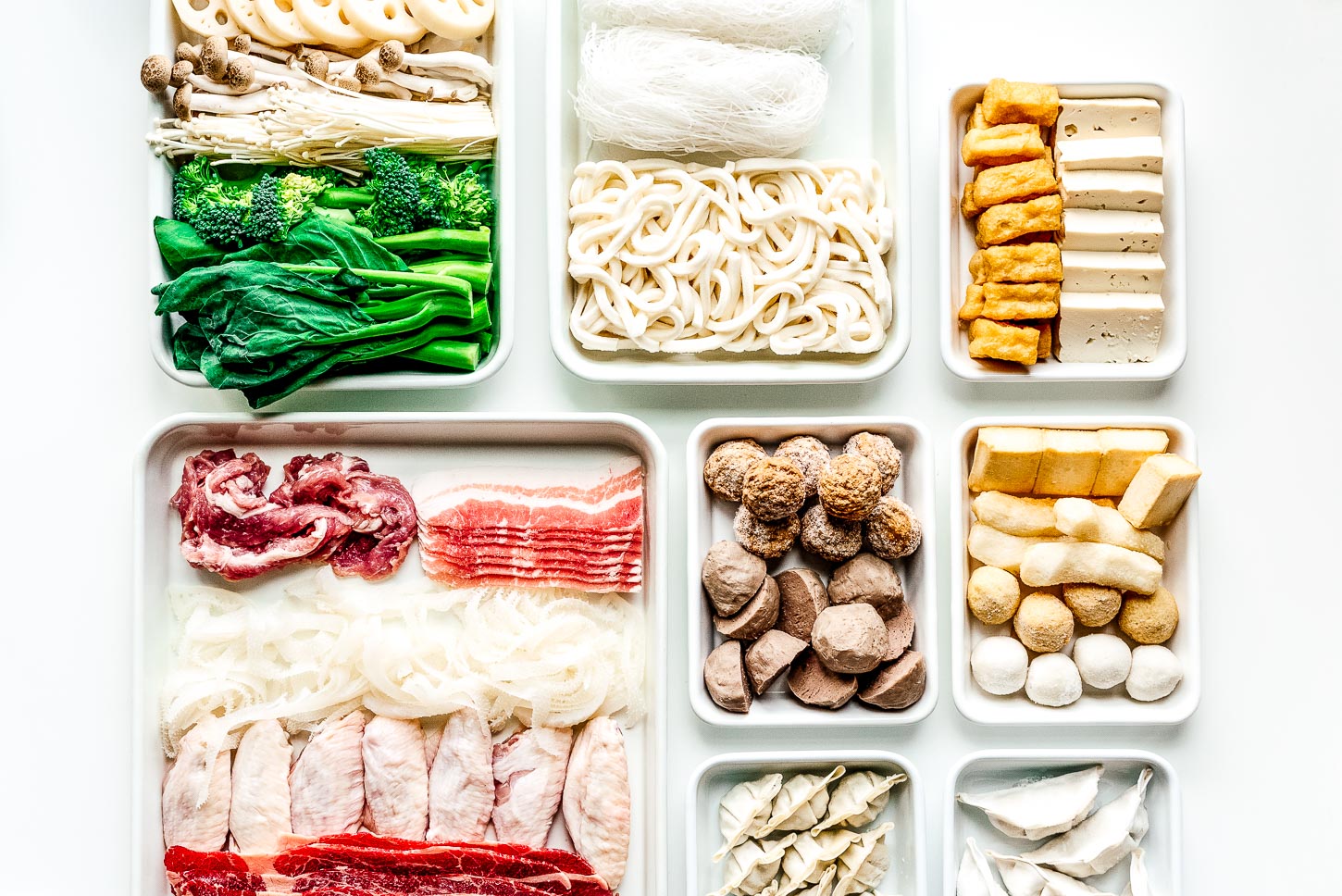

How to hot pot
Once the table is set, the soup is bubbling in the middle, and you have your own custom sauce made, this is how you do it:
- Decide on a couple of pieces of what you want to eat. Most people start with meat, but if you’re feeling dumplings, tofu, or vegetables, you do you!
- Use a pair of tongs to gently place your pieces of choice into the pot – go for 3-5 pieces per person.
- Once everything is in the pot, the bubbling will subside a bit. Let everything come back up to a simmer. If you’re cooking thinly sliced beef, you can just give it a gently swish in the bubbling soup until it is cooked to your liking then pull it out immediately.
- Use a scoop to scoop out the pieces you put in and place them in your bowl.
- Dip the pieces in your sauce, enjoy, and repeat as needed!
Note: for things like tofu and balls or daikon and potatoes, you can just pop those into the pot and let them hang out while it’s bubbling away. The can just chill out, cook slowly and soak up flavor while you’re cooking other items.
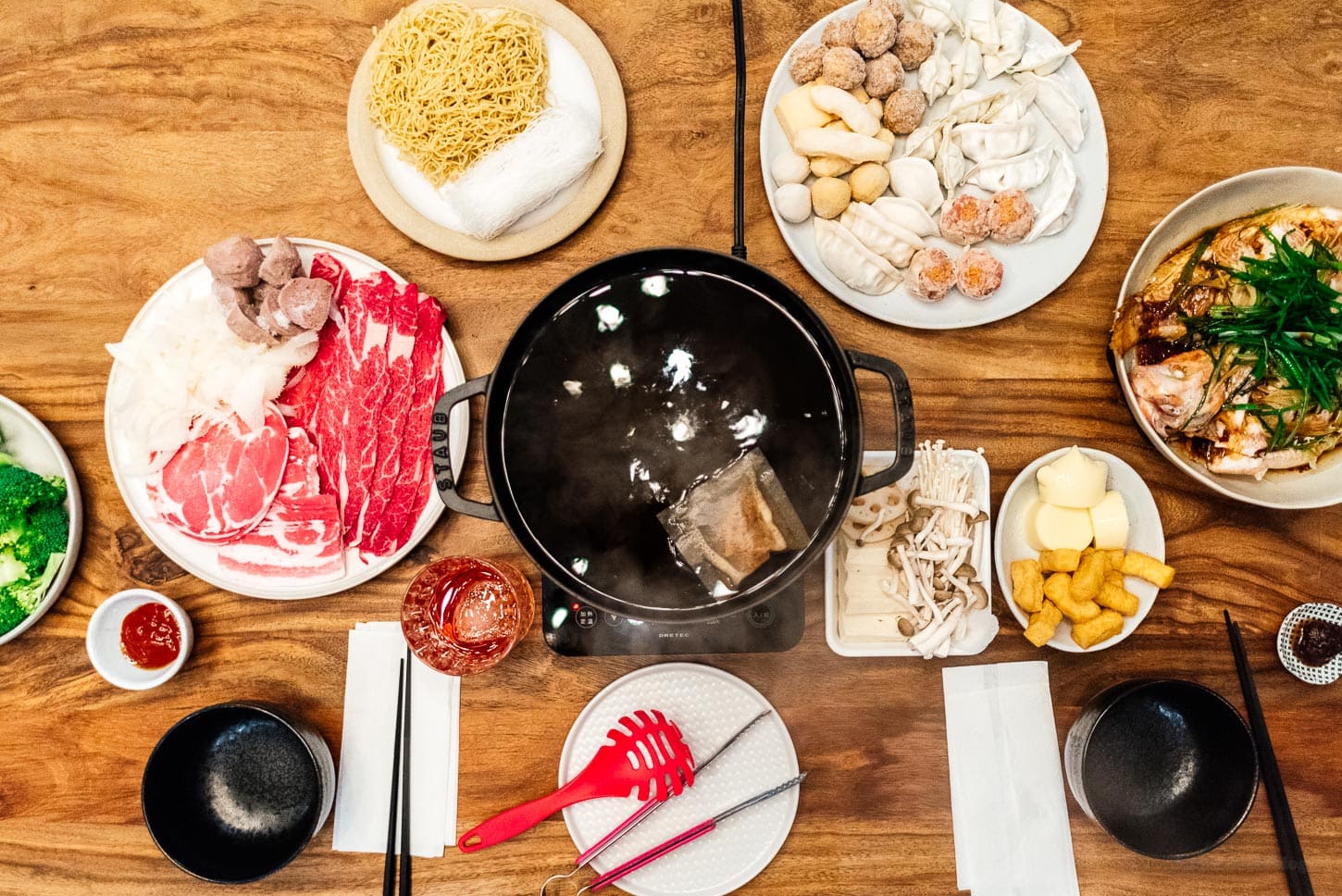

Hot pot FAQ
How do you get the food out of the hot pot?
Don’t dip your chopsticks in the pot! Use a hot pot strainer to scoop your food out. It’s easier, cleaner, and you’ll be able to find your food more quickly.
When is it cooked?
This is probably what confuses most people about hot pot. Generally, letting everything come to a boil before you start scooping food out is a good rule, but here are some *hot pot cooking times:*
- Meats – since they’re thinly sliced or cut, it shouldn’t take more than 30 seconds for beef and up to 1-2 minutes for pork, chicken, and lamb.
- Seafood – seafood cooks quickly in general, 1-2 minutes should do it.
- Vegetables – leafy greens can take a quick dip, things like potatoes will take until they’re tender, up to 15 minutes.
- Dumplings – cook these according to package directions.
- Balls – these usually come fully cooked, but give them up to 5 minutes at a boil to make sure they’re heated through.
- Noodles – cook these according to package directions.
- Tofu – this can go in as long as little as you like.
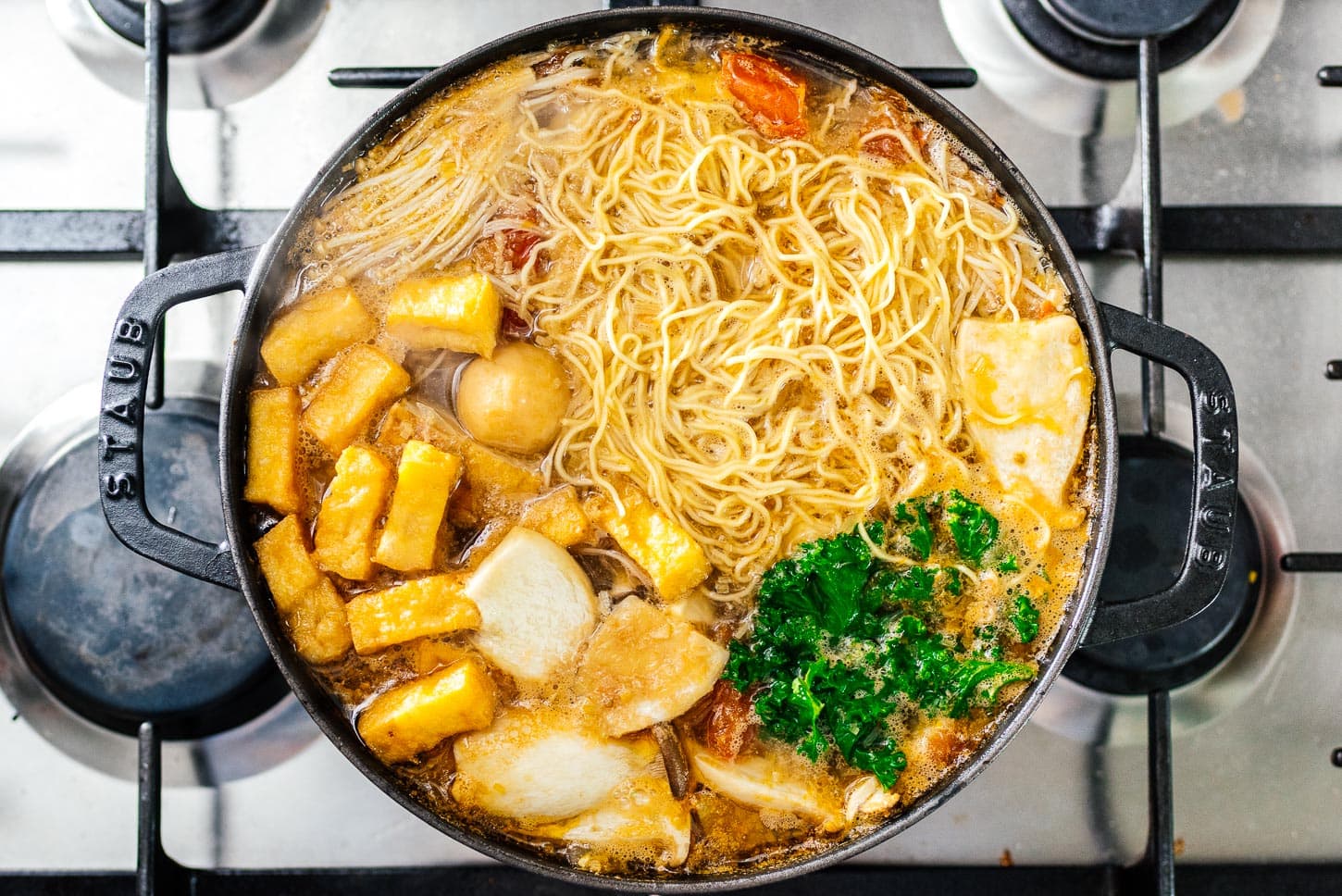

Do you add everything at once to hot pot?
It’s easier if you don’t add everything at once, just add in a few pieces at a time, the ones you want to eat. This keeps the soup bubbling and the food fresh so you don’t find a random piece of leathery beef that’s been in the pot for hours.
Help! I don’t live near an Asian supermarket and still want to hot pot
You can make do with a regular grocery store! Use chicken broth with some ginger, garlic, soy, and toasted sesame oil. Pick out some meats, freeze them slightly, and thinly slice. Get some leafy greens and check out what they have in the frozen section. There will usually be some frozen dumplings at the very least. Grab a package of tofu and some noodles you can have a scaled-down version of hot pot. Order some dipping sauces online for maximum enjoyment.
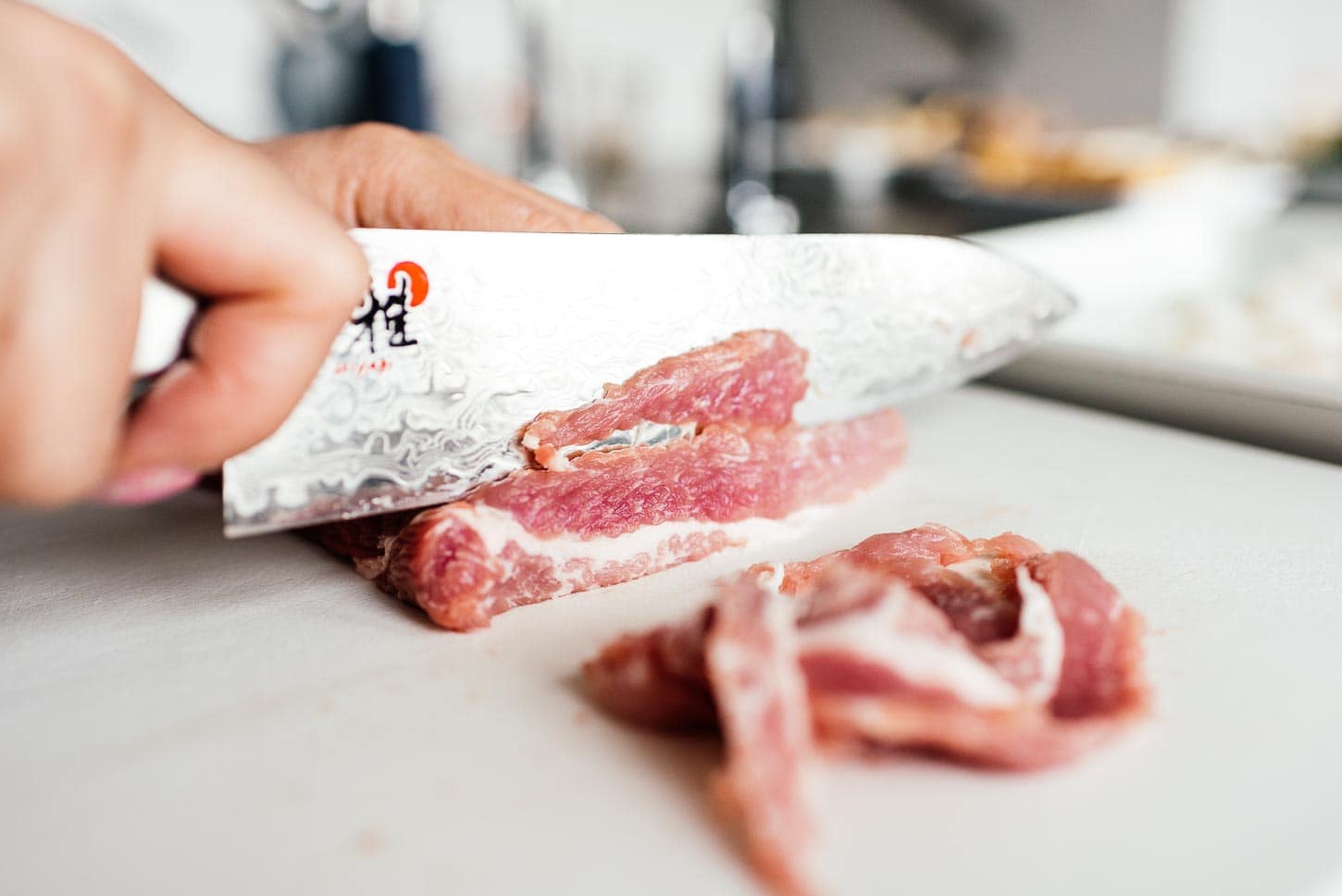

Go forth and Hot Pot
Alright my friends! You’re ready to go forth and hot pot. Cook, dip, and eat away. I hope you give this a chance. It’s so cozy and comforting and warm.
Happy hot-potting!
xoxo steph
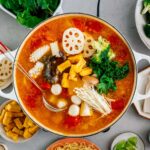

Hot Pot at Home
For maximum authenticity, get as much variety as you can. Use the scale button to change for number of guests. See post for more ingredient suggestions.
Serves 4
- 1 package hot pot soup mix see notes for substitution
- 1 lb meat at least 2 kinds, thinly sliced ribeye and pork jowl preferred
- 1 lb seafood at least 2 kinds, shrimp and salmon preferred
- 1.5 lb vegetables oyster mushrooms, broccoli, and cherry tomatoes preferred
- 1 lb tofu 1/2 firm and 1/2 tofu puffs preferred
- 8 dumplings such as gyoza or potstickers
- 8 fish balls
- 8 meatballs vietnamese preferred, ikea if needed
- 1 lb noodles frozen sanuki udon preferred
Hot Pot Sauce
- 1/4 cup soy sauce sweet soy sauce preferred
- 2 tbsp green onions thinly sliced
- 1 tsp toasted sesame seeds
- 1 Thai bird’s eye chili sliced, optional
Mike’s Hot Pot Sauce
- 2 tbsp ketchup
- 2 tbsp sugar
- 2 tbsp sriracha
- 2 tbsp shacha optional
-
induction burner
-
wide shallow pot
You can also use instant dashi powder.
Estimated nutrition doesn’t include sauce or soup.
Nutrition Facts
Hot Pot at Home
Amount Per Serving
Calories 888
Calories from Fat 230
% Daily Value*
Fat 25.6g39%
Saturated Fat 5.5g34%
Cholesterol 293mg98%
Sodium 860mg37%
Potassium 1408mg40%
Carbohydrates 32.4g11%
Fiber 5.1g21%
Sugar 5.9g7%
Protein 130.6g261%
* Percent Daily Values are based on a 2000 calorie diet.














Post Comment